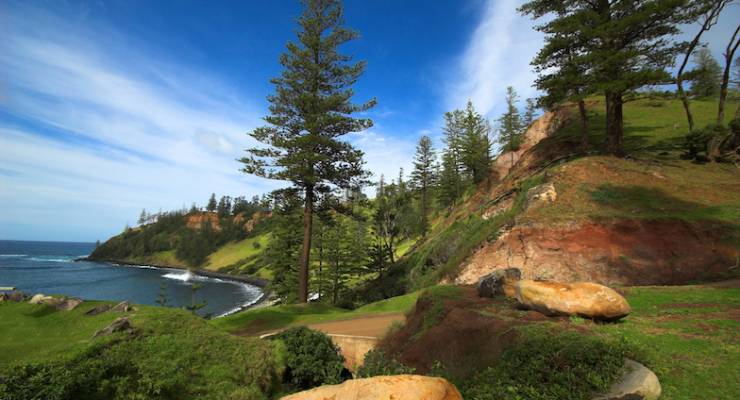
Norfolk Island could be a new offshore processing centre for asylum seekers, according to a proposal reported by Guardian Australia. And not for the first time.
In fact, it would be the third time Australia has used the remote Pacific island to detain people it considers undesirable. The first two times ended in failure, with the first penal colony abandoned due to cost; the second penal colony earned the title “Hell in the Pacific” before it too was closed.
The latest proposal for a “community detention model using local houses and accommodation to allow asylum seekers and refugees to largely live freely on the island” is a similar scenario to the first colony. In the mid-1780s, as the British drew up plans to colonise Australia, the potential supply of flax and timber from the island was considered of such importance that Governor Arthur Phillip was given instructions to settle the island “as soon as Circumstances may admit of it”. This he did in 1788, sending a landing party a mere 19 days after the First Fleet arrived at Port Jackson. The colony was soon struggling, and the mix of free settlers, soldiers and convicts living together on the small island led to several attempted mutinies. The decreasing value of the island as a source of food and resources saw the island completely abandoned by 1813.
But it was the island’s second stint as a penal colony, starting in 1824, that earned it the hellish moniker.
The British colonial authorities saw Norfolk Island as a potential dumping ground for violent criminals incapable of rehabilitation. Unlike the mainland, there would be no escape. The Governor of New South Wales, Thomas Brisbane, declared that a prisoner sent to Norfolk Island had “forfeited all claim to the protection of the law” and was “forever excluded from all hope of return”. “If it were not too repugnant to the Laws of England,” he wrote, “I should consider it very fitting to have Norfolk Island completely under Martial Law,” which would “save the complicated machinery of Civil Courts”.
Except for a brief period of reform under Captain Alexander Macononochie, the island was a cesspit of misery, violence and deprivation. Convicts wore heavy chains, worked in the open from sunrise to sunset, and resorted to murder to obtain the death penalty. According to one description of the types of punishments deployed:
“Lashings were common: sometimes up to 500 strokes. Dumb-cells were constructed to exclude light and sound; many men lost their sanity in them. Solitary confinement, increased workloads and decreased rations — sometimes bread and water — were also common forms of punishment. One documented case concerns a convict by the name of Micheal Burns who suffered a total of 2210 lashes and almost two years in confinement, much of it in solitary, three months of that in total darkness, and at least six months of those two years on a diet of bread and water only. Burns’ crimes? Insolence, suspected robbery, neglect of work, striking a fellow prisoner, bushranging, singing a song, calling for a doctor, attempted escape, and inability to work due to the debility caused by his punishments.”
When Reverend William Ullathorne visited the over-crowded cells on the island to inform 13 men they had been sentenced to death:
“… they, one after another, as their names were pronounced, dropped to their knees and thanked God that they were to be delivered from that horrible place, while the others remained mute and weeping; it was the most horrible scene I have ever witnessed.”
One of the authors of the new proposal to use Norfolk for detention, Natasha Blucher, notes that her preference was for Australia to process asylum seekers on the mainland. But “if that’s not going to happen, as it seems from [Immigration Minister Peter] Dutton’s ongoing statements and Labor’s support, I guess this is the second best”.







Repeating
Thomas Brisbane, declared that a prisoner sent to Norfolk Island had “forfeited all claim to the protection of the law” and was “forever excluded from all hope of return”
Is this not what the refugees on Manus and Nauru face right now. They have no protection from the law and police on Nauru and Manus. Not one Nauruan has ever been charged or prosecuted for an assault agan=inst a Non-Nauruan. The AFP officers stand by mute and unable to act as the Nauruan police protect their own.
As for return- Is not Dutton and his accomplices in the ALP and LIBs forever threatening the people that they have no hope of going anywhere except their current hellhole or a procured hell in Cambodia.
Our convict past bedevils us to this day. With no human rights architecture some of us have not evolved far from the flogging hanging brutal murdering land grabbers we were in the beginning.
“Convicts […] resorted to murder to obtain the death penalty.”
This claim is a myth, as shown in this paper: http://discovery.ucl.ac.uk/1331355/
Thanks Tim, that’s a really great paper. I think it states the specific murder with the hoe cited here didn’t happen. However, it does appear to confirm the general point that some “men seemingly did commit capital offences intending to be executed”, including James Burrows killing John Dursley, George Marshall attempting to kill Timothy Carroll, and George Byford possible attempted murder of Thomas Eaton Jones, among others. Regards, Luke
Surprised that you didn’t mention the resettlement of the Bounty mutineers’ descendants there when they became too numerous for Pitcairn.
Perhaps Pitcairn could become our new Devils Island?
Donning my tinfoil sombrero – could this ‘cunning plan’ be somehow linked to the determination to end Norfolk’s special immigration zone status? It used to be part of the Federal Sydney electorate, with limited franchise.